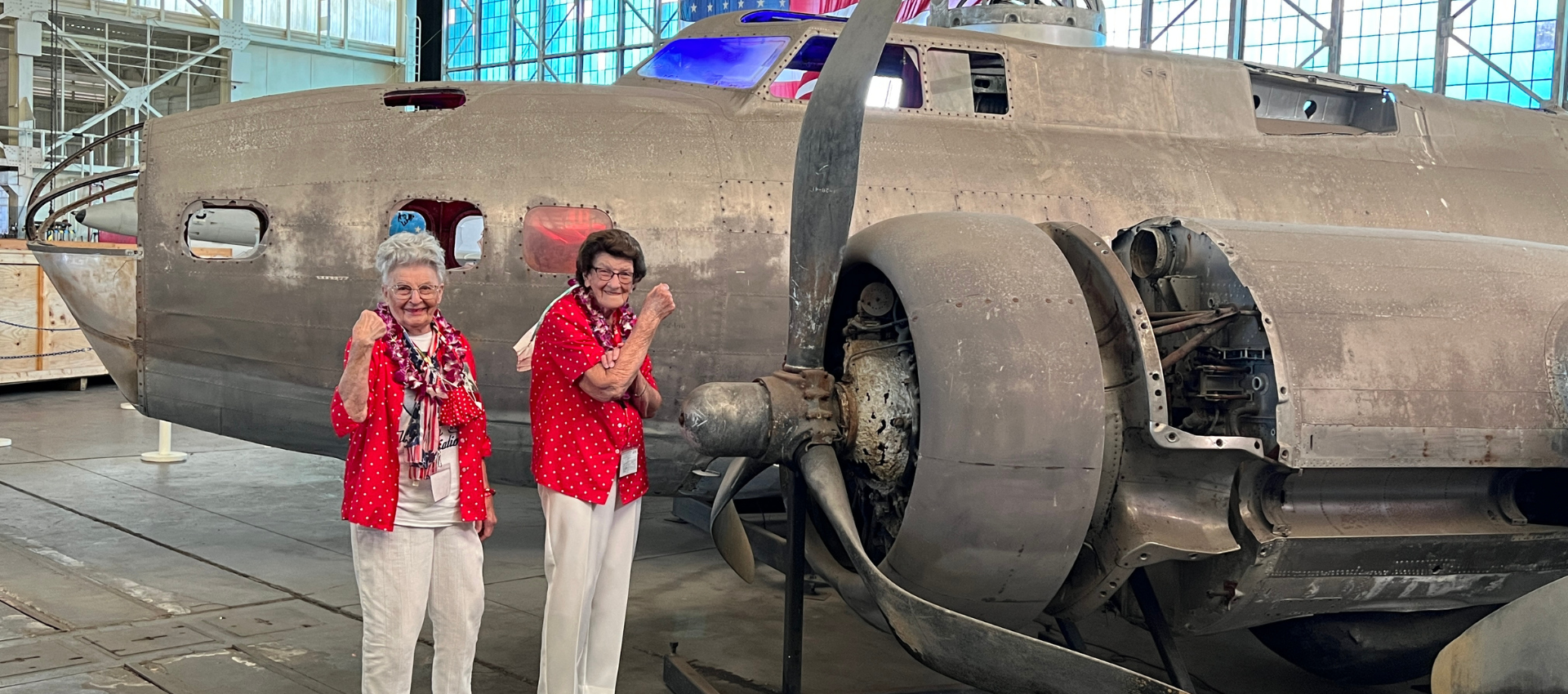“Rosie” Mae Krier & “Rosie” Marian Wynn
The week of the commemoration of the 80th anniversary of the attack on Pearl Harbor, the Museum had the honor and privilege of welcoming numerous veterans and members of the Greatest Generation. These inspiring individuals shared stories, memories, and emotions as they remembered 80 years since December 7, 1941 and their experiences throughout the years that followed that fateful day.
One particular story stars one of our aircraft and filled us with inspiration: the story of real-life World War II Rosie the Riveter, Mae Krier. Mae joined us with fellow Rosie, Marian Wynn, on December 8 – the day following the 80th anniversary of the attack on Pearl Harbor – to share their stories and reunite with an old friend.
B-17 Riveter, Mae Krier, Reunited with the Flying Fortress
Upon walking into historic Hangar 79 at Pearl Harbor Aviation Museum, Mae Krier felt chills as she was reunited with an old friend – a Boeing B-17 Bomber. As a riveter and bunker throughout the war, Mae worked on B-17 and B-29 bombers, helping build flying fortresses for American troops around the world.
In early 1943, Krier began her job at the Boeing factory in Seattle, building airplanes full time for about 90 cents an hour. In 2021, filled with overwhelming emotions, Mae looked in admiration on the Museum’s B-17, known as the Swamp Ghost, recalling the exact positions and portions on the wings where she would work. She recalls crawling into the wing cavities to help bunker each rivet – the riveter worked on the outside of the wing and the bunker had to crawl inside. Mae jokingly remembers, “you can’t be claustrophobic” to work on the wings in B-17s because of how small and cramped they are.
Krier was assigned to the wing sections of the aircraft, only getting to “see the wing get attached, but never the finished product” as she had to quickly move onto the next. Finally, 70 years after she worked on B-17s, she was able to take to the sky’s in the finished product and was amazed at what they looked like from the inside. Seeing how small the spaces were during that flight and looking at the Museum’s B-17 bomber, she expressed, “How did I ever get in there?”
Origin Stories – Just Missed Each other
The Museum’s Boeing B-17, known as the Swamp Ghost, was manufactured in the Seattle Boeing factory, the same one Mae Krier riveted in. Our Swamp Ghost was manufactured and began operation in 1941, a few years before Mae began working. Witnessing two stories with the same origins – the story of the Swamp Ghost and Mae’s Rosie story – come together was inspiring and emotional to everyone who witnessed it.
WWII Pipe Welder Marian Wynn
Marian Wynn was a pipe welder at Shipyard #3 in Richmond, California, working on and helping build liberty, victory, cargo and troop ships. Marian’s responsibility was to assemble small pieces and pipes together. The larger pieces were then brought to the ship, only needing one more weld once larger construction began, which saved a lot of time. Over the four years of the war the Richmond shipyard where Marian worked built a total of 747 ships for the war effort.
Marian joked that it was very easy to tell the difference between a man and a women’s weld on ships. Marian recalls, “humming as [she] would weld which made a nice bead, while men were always in a hurry.”
Rosies, World War II “Soldiers Without Guns”
B-17 Bombers, nicknamed the Flying Fortress because of the amount of damage they could endure and continue flying, and everything else soldiers needed – tanks, ships, ammunition, and more – were created by Rosies. Built by women just like Mae and Marion, everything soldiers and sailors needed on the front lines was created by the precise and dedicated work of Rosies on the home front all over the country.
The work of Rosies helped bring soldiers and sailors home – including the crew on the Swamp Ghost the day it crash landed, with all crew surviving with just minor cuts and bruises.
Marian shares that recently she was told by a World War II veteran that, “men on the front lines may have won a battle, but they couldn’t get home without the work of women.” Victory on the WWII battlefield was possible because of the victories on the home front.
80th Anniversary of the Attack on Pearl Harbor
Experiencing Pearl Harbor for the 80th anniversary of the attack was an amazing experience for both Mae and Marian, who love every opportunity to share their Rosie stories. Mae stated being here for the anniversary and seeing the type of airplane she helped build was, “Unbelievable. Both of us were alive when Pearl Harbor was bombed – we remember the day well and of course remember the end of the war. We worked through it, [Marian] built ships and I built airplanes.”
These two women made history and we salute their service.
“Never say you can’t do something until you try” – Marian Wynn

